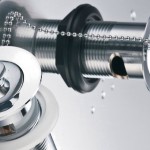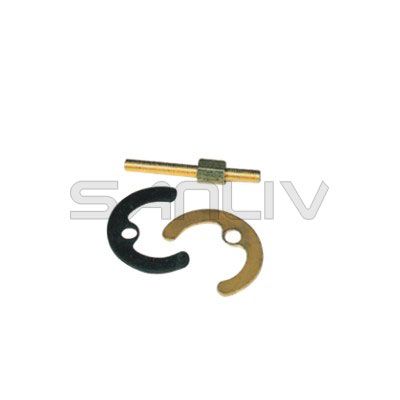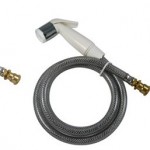كيفية تثبيت صنبور حوض الحمام? اقرأ تثبيت صنبور الحمام الخاص بنا & بالوعة الحمام نصائح غيار حنفية على الانترنت. صنبور الحمام, كما يشار إلى حنفية المرحاض أو حوض صنبور. يمكنك توفير الكثير من المال عن طريق تثبيت حمام جديد لاعبا اساسيا بنفسك.
مهم: اقرأ هذا قبل أن تبدأ
- عند استبدال صنبور قديم ، هناك بشكل عام ثلاثة أشياء يجب مراعاتها: كم عدد الثقوب التي تمتلكها بالوعة, إلى أي مدى هم, وما إذا كنت ستحتاج إلى استبدال الصرف أم لا.
- عادة ما تأتي أحواض الحمام مع ثلاثة تكوينات مختلفة من الثقب. التكوين الأكثر شعبية هو فتحتان على بعد 4 بوصات في الوسط مع وجود ثقب مركزي بينهما (إجمالي ثلاثة ثقوب). تكوين آخر مماثل هو فتحان على بعد ثماني بوصات في الوسط مع فتحة مركزية بينهما (غالبًا ما يسمى تكوين مجموعة الانتشار). أخيرا, قد يكون هناك مجرد حفرة واحدة, وهو تكوين شائع لأحدث المصارف والحنفيات الأحدث.
- ستحتاج إلى شراء صنبور يطابق نمط الثقب الخاص بك. لا ينصح بإجراء محاولة حفر ثقوب في الحوض أو محاولة جعل مجموعة الانتشار تناسب في أ 4 تكوين بوصة. استثناء واحد لهذه القاعدة, ومع ذلك, يمكن صنعه لبعض الحنفيات ذات الثقب الواحد المصممة بقاعدة عريضة تغطي الثقوب الإضافية بتكوين 4 بوصات.
- عادة, من الجيد استبدال الصرف عند استبدال الصنبور. عادة, تباع صنبور الحمام مع المصارف المنبثقة ولكن يمكنك أيضًا الحصول عليها بقابس فقط. إذا قمت باستبدال الصرف, النظر في شراء فخ وذيل جديد. من الأسهل بكثير العمل مع أنابيب جديدة أكثر من القديمة والتكلفة ليست باهظة.
قم بإزالة الصرف المنبثق الموجود
1. قم بإزالة الصامولة الموجودة فوق المصيدة P ثم قم بفك الصامولة المتصلة بالمصيدة P.
2. قم بإزالة الرافعة المنبثقة من الصرف.
3. قم بفك صامولة القفل التي تثبت الصرف في الحوض.
4. قم بفك الصرف وشفة الصرف.
قم بتثبيت الصنبور الجديد واستنزاف النافذة المنبثقة
1. ضع معجون أو شريط تفلون على سيقان الصنبور.
2. إذا كان الصنبور الخاص بك يحتوي على حشية مطاطية, قم بتثبيته على قاعدة الصنبور قبل إدخال سيقان الصنبور في الفتحات المناسبة في الحوض. إذا كان الصنبور الخاص بك لا يتضمن حشية, قم بتشغيل خط من السد تحت الصنبور قبل تثبيته.
3. تأمين المكسرات التي تحمل الصنبور إلى الحوض. قم بربط الصواميل يدويًا ثم قم بلفها ربع دورة أخرى باستخدام مفتاح الحوض.
4. قم بتوصيل أنابيب الإمداد بسيقان الصنبور.
5. قم بتطبيق معجون Teflon على مؤشرات ترابط صمام الإغلاق, وتشديد الصواميل الاقتران على SCET FAUCET. تأكد من عدم التجاوز.
6. ضع السد على الجانب السفلي من شفة الصرف, واضغطه في حفرة التصريف.
7. ضع جوز القفل على غلاف الصرف, ثم ضع غسالة معدنية وحشية على السكن.
8. المسمار الإسكان الصرف بإحكام على الحافة. إذا بدأت الحافة في الدوران, امسكه ثابتًا عن طريق إدخال المقبض البلاستيكي من الزردية الخاصة بك.
9. إسقاط الصرف المنبثق في مكانه, الحفاظ على الفتحة لدبوس التحكم باتجاه الجزء الخلفي من الحوض.
10. ضع رافعة الكفالة في الفتحة الجانبية لتجميع التصريف بحيث يناسب دبوس التحكم من خلال الفتحة المناسبة في الصرف المنبثق.
11. اضبط قضيب الصرف في الفتحة في الحنفية, وقم بتوصيل رابط التوصيل بقضيب الصنبور عن طريق ربط المسمار المرفق. تأكد من أن النافذة المنبثقة لأعلى وأن قضيب التصريف لأسفل; ثم قم بتوصيل ذراع الكفالة برابط الاتصال باستخدام مشبك V. يجب أن تنخفض النافذة المنبثقة عند سحب الرافعة لأعلى.
12. قم بتوصيل امتداد التصريف الجديد بالمصيدة P.
13. قم بتنظيف أنابيب الإمداد عن طريق إزالة جهاز التهوية من الصنبور وتشغيل الماء. بينما الماء يجري, التحقق من وجود تسربات. أغلق الماء بعد التأكد من عدم وجود تسرب, واستبدال جهاز التهوية.









